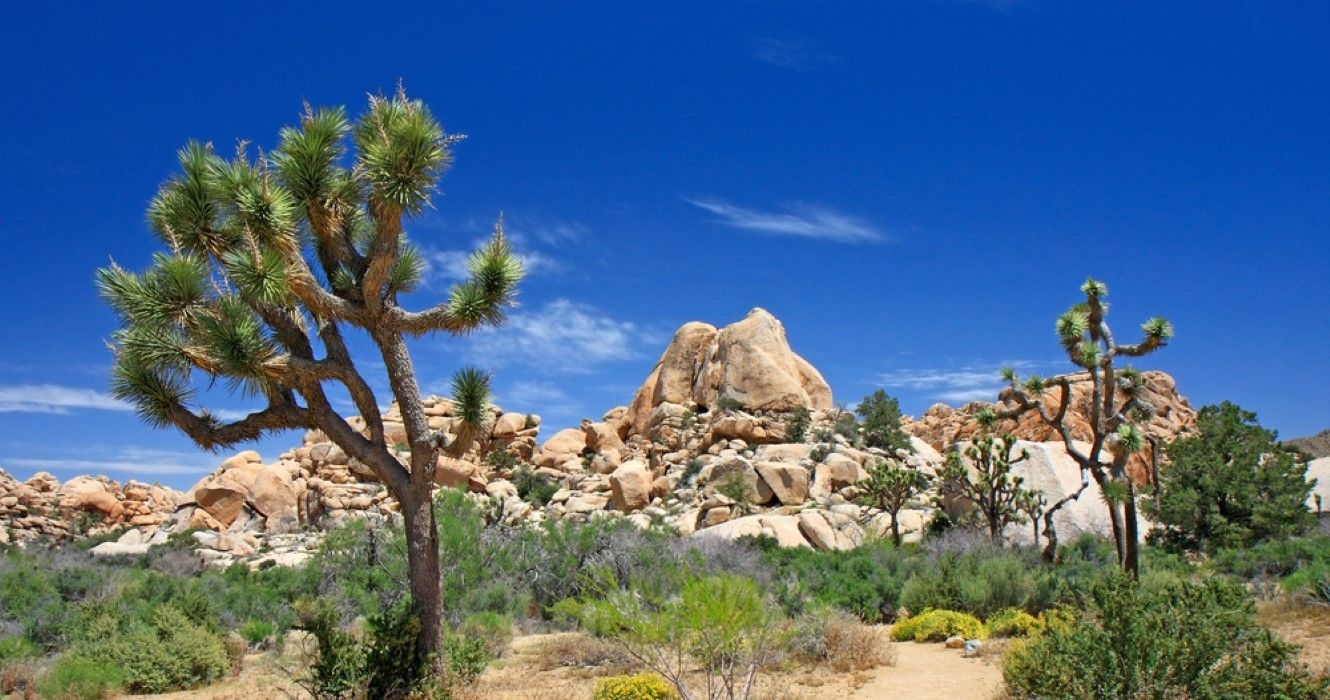Quick Links
With more than 70 trails, the famous Joshua Tree National Park is a hiker's dream, but visitors should know that while there are several easy paths, most of the park trails are of moderate or difficult level, and in a harsh desert environment trails should be selected with safety in mind.
About 2.8 million people per year visit the national park, located where the Mojave and Colorado deserts meet in southeastern California, east of San Bernardino and north of Palm Springs. The harsh climate of this ancient desert should be respected. Visitors might experience strong winds and flash floods, and summer temperatures spike to 100 degrees Fahrenheit, or higher. But even in this environment plant and animal life are found in abundance inside the park, which comprises about 790,000 acres.
Here's everything visitors should know about hiking the easier trails at Joshua Tree.
Try These Easy, Short Trails Inside Joshua Tree National Park
The park is open 24 hours every day, all year, and entry fees apply. A vehicle fee valid for seven days costs $30, and individual entry costs $15. The best time to hike inside the park is from October to May when lower temperatures are most conducive to hiking.
A review of the Joshua Tree National Park trail descriptions found these six trails among the easiest to navigate:
Bajada Trail
- .25 miles, 20 minutes
- Access: South of Cottonwood Visitor Center; .5 miles north of the South Entrance
- Details: It's a loop trail where hikers can learn about desert plants.
Cap Rock Trail
- .4 miles, 30 minutes
- Access: From the Cap Rock parking area, at the junction of Park Boulevard and Keys View Road.
- Details: Along this loop trail walkers will see boulder piles, Joshua trees, and other desert plants.
Discovery Trail
- .7 miles 45 minutes
- Access: At the Skull Rock parking area just east of Jumbo Rocks Campground.
- Details: A loop trail, it connects the Skull Rock and Split Rock Loop trails. Its easy terrain makes it appropriate for children.
Oasis of Mara Trail
- .5 miles, 35 minutes
- Access: At the Oasis Visitor Center, in Twentynine Palms.
- Details: Leashed pets are allowed on this loop trail.
Ryan Ranch Trail
- 1 mile, 1 hour
- Access: At the Ryan Ranch trailhead, about .5 mile east of Ryan Campground.
- Details: This out and back trail is on an old ranch road and walkers will see an old adobe structure.
Skull Rock Trail
- 1.7 miles, 1 to 2 hours
- Access: From the Skull Rock parking area east of Jumbo Rocks Campground.
- Details: This loop trail showcases boulder piles and desert washes, and leads to Skull Rock.
Expect Limited Cell Service In The Park (And No Gas Stations)
In addition to its many hiking trails, the national park has picnic areas, campgrounds, and lookout points with interpretive information.
It does not have any hotels, restaurants, or gas stations, so tourists must be sure to have food, water, and fuel before entering the park. Restroom facilities are located throughout the park.
It's crucial that visitors stay hydrated in the dry desert environment, and water bottle fill stations are found at the Black Rock Nature Center, the West Entrance Station, and the Joshua Tree Cultural Center.
Travelers should know that cell phone reception cannot be relied upon inside the park, according to the National Park Service.
There are four visitor centers and a cultural center inside Joshua Tree National Park: The Joshua Tree Visitor Center is located in Joshua Tree at 6554 Park Boulevard, and the Joshua Tree Cultural Center is located in Twentynine Palms, at 6533 Freedom Way.
The Cottonwood Visitor Center is located near the park's southern entrance on Pinto Basin Road. The Black Rock Nature Center is located in the Black Rock campground in Yucca Valley, at 9800 Black Rock Canyon Road.
Safety Tips To Follow Inside Joshua Tree National Park
Hiking inside Joshua Tree National Park brings visitors close to nature and provides breathtaking desert landscapes. Wildlife inside the park includes herds of desert bighorn sheep, plus black-tailed jackrabbits, coyotes, and kangaroo rats.
Located on the Pacific migratory bird flyway, the desert is a popular bird-watching destination. The spiny-looking Joshua tree, the park's namesake, is a yucca tree and a member of the agave family.
Despite its beauty and natural abundance, the park also can be a dangerous place for travelers who aren't well-prepared for the elements or for an unexpected emergency situation.
The National Park Service offers these guidelines to those venturing out into the desert oasis, even on short trails:
- Tell someone where you are going and when you plan to be back.
- Bring plenty of water, even on short hikes, including plain water and some with electrolyte replacement.
- Bring salty snacks, since they are key to replacing salt loss from sweating.
- Rest in the shade.
- Avoid hiking between 10 a.m. and 4 p.m. during the summer
- Bring a first aid kit that has bandages, ace wrap, and antiseptic.
- Bring a trail map.
- Carry a backpack that includes necessary items plus a flashlight and spare batteries.
- Wear sunblock and a hat.
- Bring a whistle and/or a signal mirror for emergency use.
- Wear waterproof clothing such as a poncho or jacket.
With these tips in mind, visitors can enjoy some of the best hiking experiences in Joshua Tree safely.

